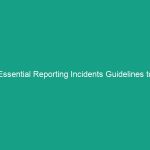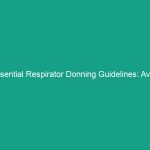Introduction
In the construction industry, Working at Height presents one of the most significant risks to workers’ safety. Each year, numerous accidents occur while employees perform tasks on scaffolding, roofs, and ladders. The importance of adhering to Health, Safety, and Environment (HSE) guidelines cannot be overstated. Effective management of risks associated with working at height is vital for ensuring the Safety of personnel and the success of construction projects. This article provides a comprehensive overview of managing construction work at height safely, focusing on the regulatory frameworks, best practices, and practical tips that can help mitigate risks and enhance Safety Standards.
Regulatory Frameworks for Working at Height
Understanding the regulatory frameworks governing construction work at height is crucial for compliance and safety. In many countries, specific Regulations outline the requirements for working at height, including the need for risk assessments, safe systems of work, and adequate Training.
International and Local Regulations
Various international standards, such as the ISO 45001 for Occupational Health and Safety Management Systems, set the groundwork for managing work-related risks. In the United States, the Occupational Safety and Health Administration (OSHA) establishes guidelines that include rules for Fall Protection and Safety Measures for workers at height. Similarly, the UK has the Work at Height Regulations 2005, which emphasize the necessity of planning work, ensuring competence, and using appropriate equipment.
Key Regulatory Elements
- Risk Assessment: Before any work begins, a thorough risk assessment must be conducted to identify potential Hazards and implement Control Measures.
- Training and Competency: Workers must receive adequate training to understand the risks and Safe Practices associated with working at height.
- Equipment Standards: All equipment used for working at height should meet established safety standards and be regularly inspected and maintained.
- Emergency Procedures: Clear emergency procedures must be established and communicated to all workers to ensure swift action in case of an incident.
Best Practices for Managing Construction Work at Height
Implementing Best Practices is essential for minimizing risks associated with construction work at height. These practices not only enhance safety but also promote a culture of health and safety within the organization.
Planning and Preparation
Effective planning is the cornerstone of safe work at height. Before any task begins, project managers should develop a comprehensive plan that includes risk assessments, method statements, and Safety Measures. This plan should outline the tasks to be performed, the equipment needed, and the personnel involved.
Use of Appropriate Equipment
Choosing the right equipment for working at height is critical. This includes selecting proper scaffolding, ladders, and harnesses. Equipment should be suitable for the specific job, and all workers should be trained on how to use it safely. Regular inspections and Maintenance checks of equipment are also vital to ensure reliability and safety during operations.
Implementing Fall Protection Measures
Fall protection measures are a fundamental aspect of managing construction work at height. These measures can include guardrails, safety nets, and personal fall arrest systems (PFAS). It is essential to evaluate the work environment and select the most appropriate fall protection measures based on the specific risks identified during the planning phase.
Continuous Training and Awareness
Safety training should not be a one-time event. Regular training sessions should be conducted to reinforce safety practices and keep workers updated on new regulations and technologies. Engaging workers in safety discussions and encouraging them to share their experiences can foster a culture of safety awareness.
Case Studies: Lessons Learned from Real-World Incidents
Examining case studies of incidents involving work at height can provide invaluable lessons for managing construction work at height. Analyzing what went wrong and identifying preventive measures can help avoid similar occurrences in the future.
Case Study 1: The Importance of Proper Training
In 2019, a construction worker fell from a roof while performing maintenance work. An investigation revealed that the worker had not received adequate training on fall protection methods. This incident highlighted the critical need for ongoing training programs and ensuring that all workers are familiar with safety protocols before they engage in high-risk activities.
Case Study 2: Equipment Failure
Another incident involved the collapse of a scaffold due to improper assembly. The workers involved had not been trained on the correct procedures for erecting scaffolding. This case underscores the importance of using qualified personnel for equipment assembly and the necessity of adhering to Safety Guidelines during setup.
Challenges in Managing Construction Work at Height
Despite the established guidelines and Best Practices, several challenges persist in managing construction work at height. Recognizing these challenges is the first step toward effective risk management.
Workplace Culture and Attitudes
One of the significant challenges is the prevailing workplace culture. If safety is not prioritized, it can lead to complacency among workers and increased risks. Organizations must cultivate a culture that emphasizes safety through leadership commitment, open communication, and the involvement of all employees in safety initiatives.
Budget Constraints
Budget constraints can also hinder effective safety management. Investing in high-quality safety equipment and comprehensive training programs requires financial resources, which may not always be available. However, it is essential to view safety as an investment rather than an expense, as the costs associated with accidents far outweigh the expenses of implementing safety measures.
Keeping Up with Regulations
The construction industry is subject to constantly evolving regulations. Keeping up with these changes can be challenging, especially for smaller companies with limited resources. Establishing a dedicated safety officer or team can help organizations stay informed about regulatory updates and ensure compliance.
Future Trends in Height Safety Management
As the construction industry evolves, so do the methods and technologies used to manage safety at height. Understanding these trends can help organizations stay ahead of potential risks.
Technological Advancements
Technology plays a crucial role in improving safety measures for working at height. Innovations such as drones for site inspections, augmented reality for training, and wearable safety devices are becoming more prevalent. These technologies can enhance risk assessment and monitoring, making it easier to ensure compliance with safety standards.
Enhanced Training Techniques
Virtual reality (VR) is increasingly being used for safety training, allowing workers to experience real-life scenarios in a controlled environment. This immersive training method can significantly improve knowledge retention and prepare workers for actual work conditions.
Conclusion
In conclusion, managing construction work at height safely is a multifaceted process that requires a commitment to understanding regulations, implementing best practices, learning from past incidents, and being aware of challenges and future trends. By prioritizing safety and fostering a culture of awareness, organizations can significantly reduce risks associated with working at height. It is crucial for all stakeholders in the construction industry to collaborate and take proactive steps towards enhancing safety standards. Let us commit to prioritizing health, safety, and the environment, ensuring that every worker returns home safely at the end of the day.


